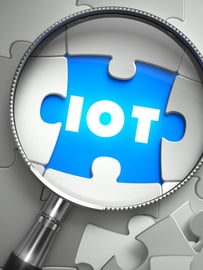Technology Trends - 2022
Internet of Things (IoT) / Internet of Behaviors (IoB)
 The IoT describes physical objects with sensors, processing ability, software, and other technologies that connect and exchange data with devices and systems over communications networks. Many of these devices are currently being offered with WiFi connectivity.
The IoT describes physical objects with sensors, processing ability, software, and other technologies that connect and exchange data with devices and systems over communications networks. Many of these devices are currently being offered with WiFi connectivity.
The IoT is at the early stages of the technology trend. It is forecasted that by 2030 approximately 125 billion IoT devices will be in use and thus creating a massive web of interconnected devices. By 2025, the IoT data volume will be 79.4 zettabytes (a zettabyte is 1,000 exabytes - one exabyte is 1,000 petabytes - one petabyte is 1,000 terabytes). To put that in perspective, a zettabyte is enough storage for 30 billion 4K movies. The global spending on IoT is forecast to reach $1.1 trillion in 2022 with the new technologies such as 5G expected to help drive the market growth.
%20with%20multicolored%20radial%20background.jpeg?width=267&name=Internet%20of%20Things%20infographic%20(bitmapped)%20with%20multicolored%20radial%20background.jpeg) The IoB collects, analyzes, responds and understands various types of behaviors to improve the user experience. IoB seeks to understand how, when, and why individuals use technology to make decisions. IoB combines the behavioral science, edge analytics, and the Internet of Things fields of study.
The IoB collects, analyzes, responds and understands various types of behaviors to improve the user experience. IoB seeks to understand how, when, and why individuals use technology to make decisions. IoB combines the behavioral science, edge analytics, and the Internet of Things fields of study.
IoB is designed to gather, aggregate, and analyze data generated from a wide variety of sources. These sources include household digital devices, wearable computers, social media, facial recognition, and online activities. The data is then analyzed in terms of behavioral psychology to look for patterns.
An important goal of the IoB is to help researchers understand the massive amount of data produced by the IoT network nodes. According to Gartner, approximately 40% of individuals will have had their behavior tracked via the IoB globally by 2023. Also, according to Gartner, IoB captures the “digital dust” of people’s lives from a variety of sources. That collected information can then be used to influence behavior.
Reference:
- Internet of Things (IoT):
https://en.wikipedia.org/wiki/Internet_of_things - How Many IoT Devices Are There in 2022?:
https://techjury.net/blog/how-many-iot-devices-are-there/ - Internet of Behavior (IoB):
https://www.techopedia.com/definition/34552/internet-of-behaviors-iob - Gartner: Top Strategic Technology Trends for 2021:
https://emtemp.gcom.cloud/ngw/globalassets/en/information-technology/documents/insights/top-tech-trends-ebook-2021.pdf - Worldwide Spending on the Internet of Things (IoT):
https://www.statista.com/statistics/668996/worldwide-expenditures-for-the-internet-of-things/ - The Top 10 Tech Trends In 2022 Everyone Must Be Ready For Now:
https://bernardmarr.com/the-top-10-tech-trends-in-2022-everyone-must-be-ready-for-now/ - What Is the Future of Tech: 23 Technologies by 2022:
https://www.computer.org/publications/tech-news/trends/2022-report - The top trends in tech:
https://www.mckinsey.com/business-functions/mckinsey-digital/our-insights/the-top-trends-in-tech - Tech Trends 2022:
https://www2.deloitte.com/us/en/insights/focus/tech-trends.html
https://www2.deloitte.com/content/dam/insights/articles/US164706_Tech-trends-2022/DI_Tech-trends-2022.pdf - Top 9 New Technology Trends for 2022:
https://www.simplilearn.com/top-technology-trends-and-jobs-article - Top 10 essential technology trends you must follow in 2022:
https://www.itproportal.com/features/top-10-essential-technology-trends-you-must-follow-in-2022/ - Meet me in the metaverse: The continuum of technology and experience, reshaping business:
https://www.accenture.com/us-en/insights/technology/technology-trends-2022 - Exploding Topics:
https://explodingtopics.com/blog - Tech Trends for 2022 and Beyond:
https://www.rutgers.edu/news/tech-trends-2022-and-beyond-0
